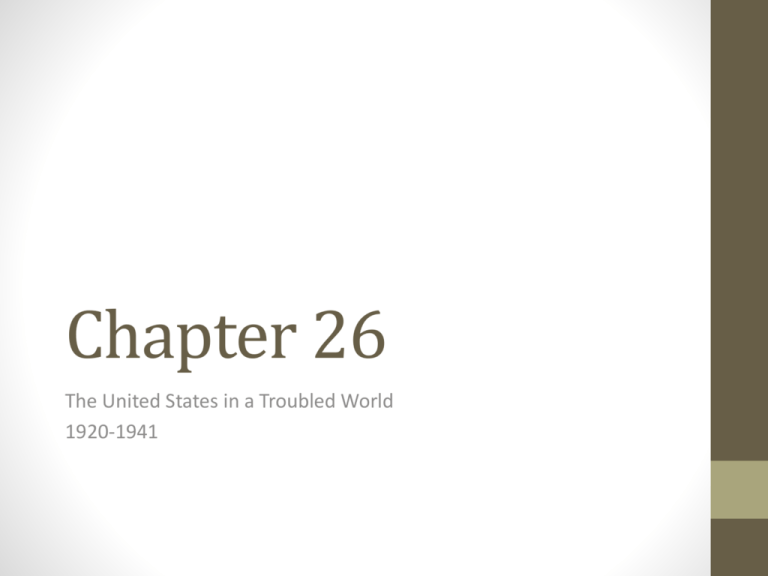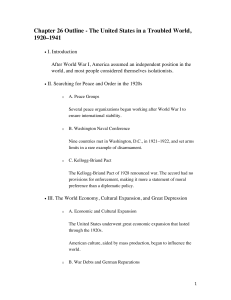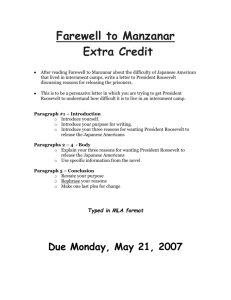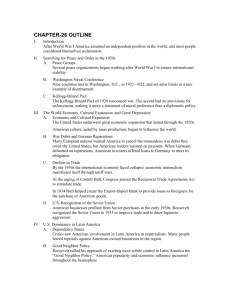Chapter 26 Lecture
advertisement

Chapter 26 The United States in a Troubled World 1920-1941 I. Introduction • After World War I, America assumed an independent position in the world, and most people considered themselves isolationists. II. Searching for Peace and Order in the 1920s A. Peace Groups • Several peace organizations began working after World War I to ensure international stability. B. Washington Naval Conference • Nine countries met in Washington, D.C., in 1921– 1922, and set arms limits in a rare example of disarmament. C. Kellogg-Briand Pact • The Kellogg-Briand Pact of 1928 renounced war. The accord had no provisions for enforcement, making it more a statement of moral preference than a diplomatic policy. The Women’s Peace Union (WPU) distributed this flier in the 1920s to remind Americans of the human costs of the First World War. One of many peace societies active in the interwar years, the WPU lobbied for a constitutional amendment requiring a national referendum on a declaration of war. In the 1930s, Representative Louis Ludlow (Democrat from Indiana) worked to pass such a measure in Congress, but he failed. III. The World Economy, Cultural Expansion, and Great Depression A. Economic and Cultural Expansion • The United States underwent great economic expansion that lasted through the 1920s. • American culture, aided by mass production, began to influence the world. B. War Debts and German Reparations • Many European nations wanted America to cancel the tremendous war debts they owed the United States, but American leaders insisted on payment. When Germany defaulted on reparations, American investors offered loans to Germany to meet its obligation. John D. Rockefeller Jr. (1874–1960) (second from right) traveled to China in 1921 for the dedication of the Peking Union Medical College, a project of the Rockefeller Foundation, the philanthropic organization founded in 1913 by oil industrialist John D. Rockefeller Sr. At the center of this photograph is Xu Shi Chang (1855–1939), China’s president. III. The World Economy, Cultural Expansion, and Great Depression C. Decline in Trade • By the 1930s, the international economy faced collapse; economic nationalism manifested itself through tariff wars. • At the urging of Cordell Hull, Congress passed the Reciprocal Trade Agreements Act to stimulate trade. • In 1934, Hull helped create the Export-Import Bank to provide loans to foreigners for the purchase of American goods. D. U.S. Recognition of the Soviet Union • American businesses profited from Soviet purchases in the early 1930s. Roosevelt recognized the Soviet Union in 1933 to improve trade and to deter Japanese aggression. American and Russian laborers fraternize during the building of the Henry Ford plant at Nizhny Novgorod, Soviet Union, in November 1930. This factory, scheduled to turn out 30,000 cars a year, was one of numerous American businesses entering the Soviet marketplace in this period. Others included Westinghouse, Caterpillar, John Deere, American Express, and RCA. IV. U.S. Dominance in Latin America A. American Economic Muscle • Critics saw American involvement in Latin America as imperialistic. Many people feared reprisals against Americanowned businesses in the region. B. Good Neighbor Policy • Roosevelt called his approach of exerting more subtle, less blatant, control in Latin America the “Good Neighbor Policy.” American popularity and economic influence increased throughout the hemisphere. • Despite the Good Neighbor Policy, the Roosevelt administration continued to support dictators in Latin America in the belief that they would promote stability and preserve U.S. economic interests. The United States and Latin America Between the Wars. The United States often intervened in other nations to maintain its hegemonic power in Latin America, where nationalists resented outside meddling in their sovereign affairs. The Good Neighbor policy decreased U.S. military interventions, but U.S. economic interests remained strong in the hemisphere. IV. U.S. Dominance in Latin America C. Clash with Mexican Nationalism • In 1938, Mexico nationalized foreign-owned petroleum companies. Fearing that Mexican oil would end up in Germany or Japan, Roosevelt acquiesced to the move. Among the U.S. companies with large holdings in Latin America in the interwar period was F. W. McLaughlin & Co. of Chicago. Here, workers on a private company wharf in Santos, Brazil, prepare to load coffee for shipment to the United States. C. Clash with Mexican Nationalism • In 1938, Mexico nationalized foreign-owned petroleum companies. Fearing that Mexican oil would end up in Germany or Japan, Roosevelt acquiesced to the move. Sergeant Fulgencio Batista, center, hand on belt, is shown here September 7, 1933. From his place as top sergeant in the Cuban Army, he took the title of “Revolutionary Chief of Armed Forces”in the army coup that caused the downfall of the de Cespedes government one day earlier, on September 6, 1933. C. Clash with Mexican Nationalism • In 1938, Mexico nationalized foreign-owned petroleum companies. Fearing that Mexican oil would end up in Germany or Japan, Roosevelt acquiesced to the move. V. The Course to War in Europe A. German Aggression Under Hitler • In 1936, German troops moved into the Rhineland and Hitler formed an alliance with Italy and Japan. The Anti-Comintern Pact united Germany and Japan against Russia. • Hitler convinced representatives of Britain and France to not oppose his annexation of Czechoslovakia. B. Isolationist Views in the United States • Isolationist views were expressed by both conservatives and liberals. Although strongest in the Midwest, isolationist sentiment was a nationwide phenomenon accepted by a majority of Americans. V. The Course to War in Europe C. Nye Committee Hearings • Isolationists in the 1930s believed that American involvement in World War I had been a mistake and feared that business interests might take the nation into a war because of ties to Germany and Italy. • Roosevelt supported isolationism, a position reflected in the Neutrality Acts of 1935, 1936, and 1937. D. Roosevelt’s Evolving Views • Roosevelt became increasingly troubled by the aggressive behavior of Germany, Italy, and Japan. V. The Course to War in Europe E. Poland and the Outbreak of World War II • Britain and France announced that they would defend Poland’s independence. When Hitler invaded Poland in 1939, they declared war on Germany. • In 1939 at Roosevelt’s request, Congress repealed the arms embargo and approved cash-and-carry exports of arms German leader Adolf Hitler (1889–1945) is surrounded in this propagandistic painting by images that came to symbolize hate, genocide, and war: Nazi flags with emblems of the swastika, the iron cross on the dictator’s pocket, Nazi troops in loyal salute. The anti-Semitic Hitler denounced the United States as a “Jewish rubbish heap”of “inferiority and decadence”that was “incapable of conducting war.” The German Advance. Hitler’s drive to dominate Europe pushed German troops deep into France and the Soviet Union. Great Britain took a beating but held on with the help of American economic and military aid before the United States entered the Second World War in late 1941. E. Poland and the Outbreak of World War II • Britain and France announced that they would defend Poland’s independence. When Hitler invaded Poland in 1939, they declared war on Germany. • In 1939 at Roosevelt’s request, Congress repealed the arms embargo and approved cash-and-carry exports of arms German propaganda postcard showing Panzer tanks during the blitzkrieg. German troops entering Poland after the blitzkrieg. The front page of London’s Evening Standard newspaper on September 1, 1939, announcing the German invasion of Poland. VI. Japan, China, and a New Order in Asia A. Jiang Jieshi • In the 1920s, Jiang Jieshi ousted Mao Zedong and won the support of the United States, which increased Japanese suspicions of Chinese-American relations. B. Manchurian Crisis • Japan seized Manchuria in 1931, and the United States responded with the Stimson Doctrine of nonrecognition. C. Roosevelt’s Quarantine Speech • In October 1937, Roosevelt denounced international aggression in his “quarantine speech.” VII. U.S. Entry into World War II A. First Peacetime Military Draft • The Selective Training and Service Act of 1940 resulted in 16 million young men signing up for the draft. • The Lend-Lease Act of 1941 went into effect to help Britain avoid defeat. The United States became the “arsenal for democracy” by lending and leasing American military goods to those fighting the Axis powers. VII. U.S. Entry into World War II B. Atlantic Charter • In August 1941, Roosevelt and British Prime Minister Winston Churchill signed the Atlantic Charter, which set war aims of collective security, self-determination, economic cooperation, and freedom of the seas. • When a German U-boat fired at an American destroyer, the United States entered into an undeclared naval war with Germany. • Relations with Germany deteriorated further when a German submarine torpedoed the U.S. destroyer Kearny in October 1941. • Congress scrapped the cash-and-carry policy and revised the Neutrality Acts after the sinking of the Reuben James in late October 1941. President Franklin D. Roosevelt (left) and British prime minister Winston Churchill (1874–1965) confer on board a ship near Newfoundland during their summit meeting of August 1941. During the conference, they signed the Atlantic Charter. On his return to Great Britain, Churchill told his advisers that Roosevelt had promised to “wage war” against Germany and do “everything”to “force an incident.” VII. U.S. Entry into World War II C. U.S. Demands on Japan • When Japan signed the Tripartite Pact, the United States stopped selling aviation fuel and scrap metal to them. With the occupation of French Indochina, America froze Japanese assets, ending most trade, including oil, with Japan. D. Surprise Attack on Pearl Harbor • On December 7, 1941, the Japanese made a surprise attack on Pearl Harbor, Hawai’i. This attack turned American sentiment sharply against the Japanese. Japanese Expansion Before Pearl Harbor. The Japanese quest for predominance began at the turn of the century and intensified in the 1930s. China suffered the most at the hands of Tokyo’s military. Vulnerable U.S. possessions in Asia and the Pacific proved no obstacle to Japan’s ambitions for a Greater East Asia Co-Prosperity Sphere. VII. U.S. Entry into World War II E. Explaining Pearl Harbor • Roosevelt did not conspire to leave the fleet vulnerable to attack; the Japanese caught the American forces off guard because no one thought they would attack so far from home. The United States declared war on Japan, and three days later Germany and Italy declared war on the United States. • The war came because of a fundamental clash of systems. The United States sought a liberal capitalist world order with all nations enjoying freedom of trade and investment. The dictators did not. F. Avoidable War? • More flexibility in the American negotiating posture in the fall of 1941 could possibly have delayed a showdown with Japan. The stricken USS West Virginia was one of eight battleships caught in the surprise Japanese attack at Pearl Harbor, Hawai’i, on December 7, 1941. In this photograph, sailors on a launch attempt to rescue a crew member from the water as oil burns around the sinking ship. Reading Questions. Please use the notes to respond the following questions. • Describe the views of an isolationist. • What did the Export-Import Bank of the United States provide? • Why did President Roosevelt approve diplomatic recognition of the Soviet government? • How did the Good Neighbor policy differ from previous actions in Latin America? • Why did Great Britain and France declare war on Germany?





